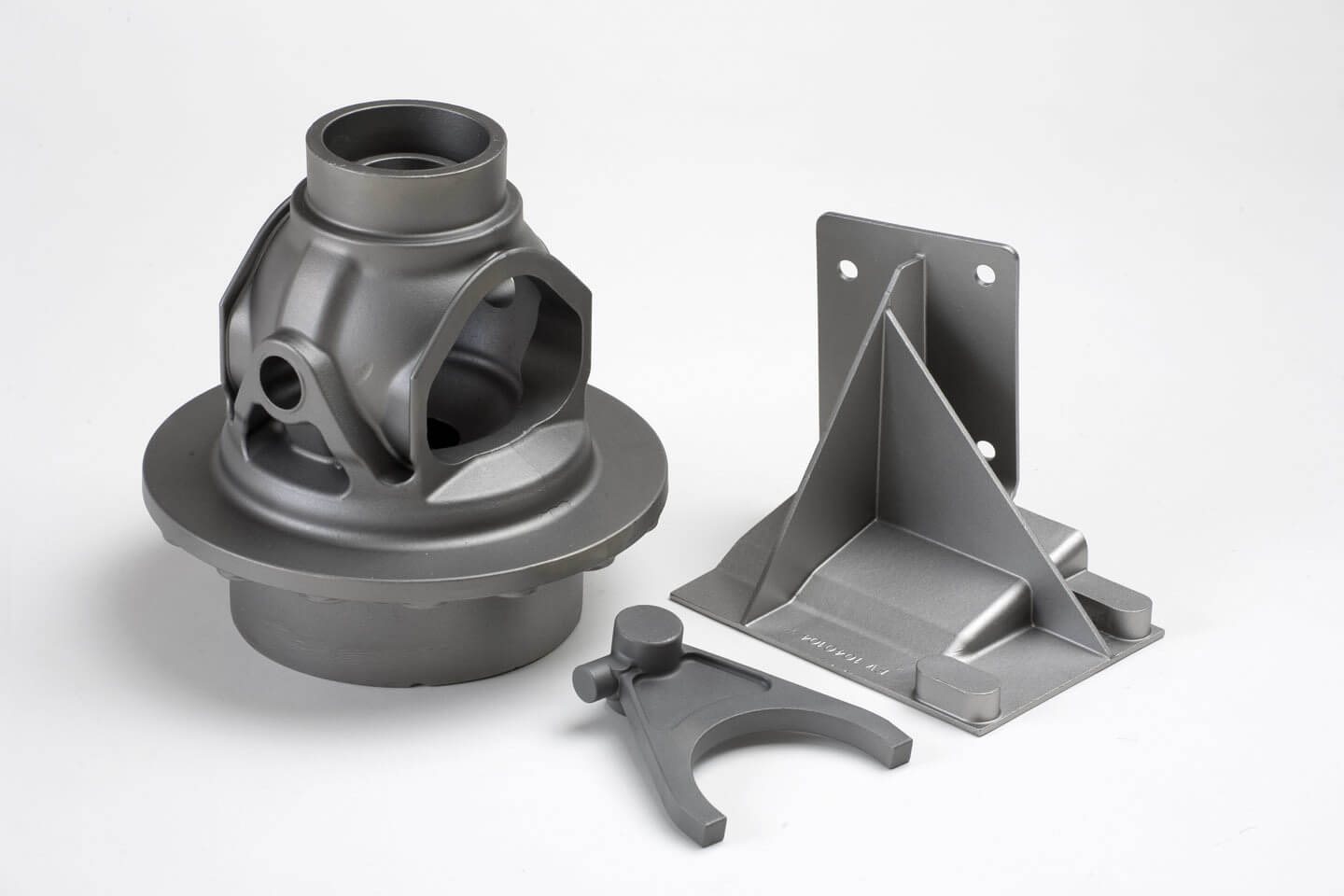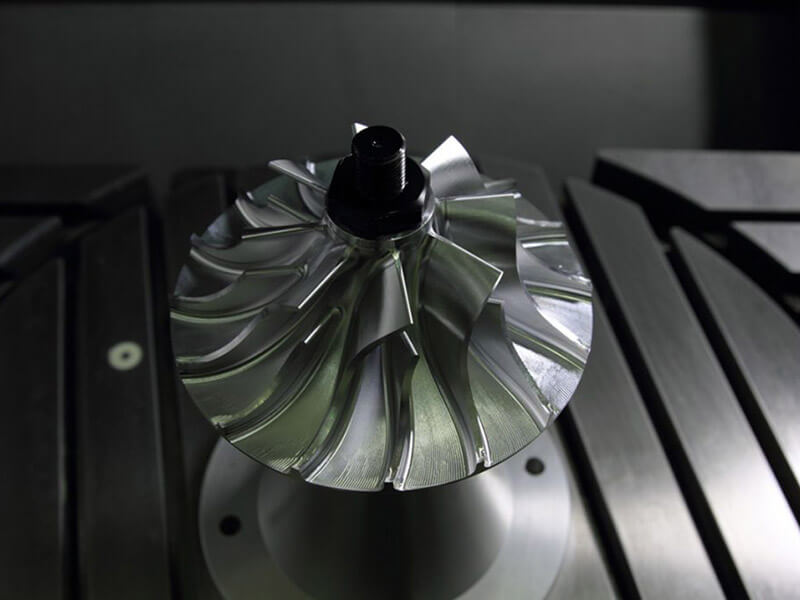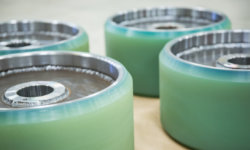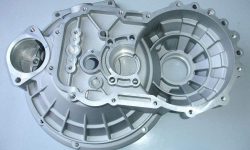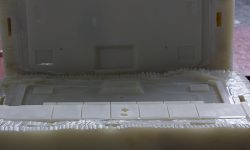From engine blocks to door handles, die casting is a fast, accurate, and repeatable metal production technique suitable for large or small parts. Die casting parts have an excellent surface finish, and the process is compatible with a range of non-ferrous metals.
Because of the high startup costs associated with die casting, the process is typically used for high-volume production, where the scale of manufacturing makes up for the high machinery and tooling costs. Die cast prototypes and low-volume production runs are harder to obtain, as it is in the economic interests of die casting companies to work with customers placing bulk orders. However, 3ERP currently provides a unique die casting solution for customers wishing to place smaller die casting orders.
This article takes an in-depth look at metal die casting, explaining the suitable materials, surface finishes, and applications for the process.
What is die casting?
Die casting is a type of metal casting that uses high pressure to force molten metal into a mold cavity formed by two dies. It shares traits with the plastic manufacturing process of injection molding.
Within the larger metal casting landscape, die casting is one of the most popular techniques due to its accuracy, high quality, and level of detail. The broader category of metal casting, which has existed for thousands of years, contains many different processes that use a mold to form liquid metal. Historically, such a process usually involved pouring the liquid metal into the mold with the aid of gravity — and many metal casting processes still work this way. Die casting, however, is a relatively new form of metal casting, introduced in the 19th century, and it uses pressure instead of gravity to fill the mold cavity.
Die casting is sometimes called high-pressure die casting, due to the amount of pressure — typically 10–140 megapascals — used to force the metal into the mold cavity. The related process of low-pressure die casting (LPDC) is less common. Die casting typically falls into one of two categories: hot-chamber die casting and cold-chamber die casting, which are suitable for different types of metal. However, there are also other more niche types of die casting, such as semi-solid metal casting (SSM).
How die casting works
In simple terms, metal die casting works by using high pressure to force molten metal into a mold cavity, which is formed by two hardened steel dies. Once the cavity is filled, the molten metal cools and solidifies, and the dies open up so the parts can be removed. In practice, however, there are many steps in the process, and skilled engineers are required to operate die casting equipment.
Here we will divide the die casting process into three stages:
- Moldmaking
- Casting
- Post-machining
How to make a die casting mold
A die casting mold consist of at least two halves: the cover side (mounted on a fixed plate) and the ejector side (on a moveable plate). Some dies also have other sections like slides and cores, which are used to produce more complex parts, such as those with holes and threads.
Depending on the size of the manufactured parts, a die casting mold may have multiple cavities to enable the production of multiple parts per cycle. Such molds either have several identical cavities (multiple-cavity die) or a mix of different cavities to produce different parts (unit die).
Tooling for die casting must be incredibly strong and thermally resistant, in addition to having good wear resistance and ductility. They are therefore made from high-performance hardened tool steels — often heat-treated — allowing them to go through hundreds of casting cycles per hour and up to two million cycles over their entire lifespan. Die casting tooling must maintain performance under very high clamping forces.
Making a die casting mold starts with computer-aided design (CAD) used in conjunction with casting-specific design and simulation tools. As with injection molds, tooling for die casting must have sprue holes, runners, and gates to allow the molten material to enter the cavity. Locking pins and ejector pins must also be incorporated to secure the mold and facilitate ejection. The digital design of the mold allows for the creation of complex shapes and tight tolerances.
CNC machining is widely used to manufacture the die casting tooling. Typically, die casting moldmaking begins with rough machining of the mold shape, followed by heat treatment of the metal mold, then finally a round of finish machining. Prototype-grade dies can also be made using rapid tooling, using either CNC machining or other processes like selective laser sintering (SLS).
How to cast metal parts
Similar to injection molding , after moldmaking, the die casting parts can be made in the die casting machine. The die casting process comprises four main stages: preparation, filling, ejection, and shakeout.
However, the casting process varies slightly depending on whether a hot chamber or cold chamber is used. These two variants of the high-pressure die casting process offer different advantages: one is good for high-speed casting, while the other accommodates a wider variety of casting materials.
Hot chamber die casting
During hot chamber die casting, the metal die casting machine contains the necessary equipment for heating up the metal to a molten state. Because it is a self-contained system, it is much faster than the alternative, offering short cycle times, though it is only suitable for a selection of casting materials, including zinc, tin, and lead alloys.
Cold chamber die casting
The cold chamber die casting process requires the use of a separate furnace to heat the metal. This naturally slows down production rates, as the molten metal must be brought to the die casting machine with a ladle. However, because a separate furnace is more powerful than a hot chamber die casting machine, metals with high melting points can be cast. This method is suitable for aluminum casting.
Regardless of whether hot chamber or cold chamber machine is used, the metal die casting process typically proceeds as follows:
- Mold preparation
- Filling
- Ejection
- Shakeout
During mold preparation, the interior surfaces of the two die halves are coated with a lubricant to facilitate ejection once the castings are complete. The die halves can then be closed and secured with locking pins.
Filling of the mold is achieved using a pressure system. This system differs between hot chamber and cold chamber systems. In both, the end result is molten metal being forced by a plunger into the mold cavity via the sprue. High pressures — up to 35 megapascals in a hot chamber and 140 megapascals in a cold chamber — ensure fast and comprehensive filling, which in turn leads to consistent cooling that prevents uneven shrinkage and consequent part deformation. Pressure is maintained during cooling.
The two die halves are opened and the ejector pins are used to remove the castings. Typically, the dies are then immediately re-closed ready for the next shot. Meanwhile the finished castings are ready for shakeout, which involves removing scrap sections of the shot such as sprues, runners, and flash (seepage of material at the parting line). This material removal can be achieved using manual tools, tumbling, or with a hydraulic trim die.
Post-machining
Many metal die casting parts require minimal secondary operations. This is due to the high pressures involved, which enable a high level of detail and good surface finish. However, many net-shape and near-net-shape castings also require precision machining for holes, threads, and other features. Some casting metals are easier to machine than others: magnesium die casting and aluminum die casting, for instance, are highly suited to post-machining.
A secondary benefit of post-machining die castings is the ability to use the on-machine inspection capabilities of the CNC machine, allowing the machinist to validate the parts.
Die casting applications
Die casting is a powerful, versatile process suitable for a range of parts, from engine components to electronics housings. Reasons for the versatility of die casting include its large build area, range of material options, and ability to make detailed, repeatable, thin-walled parts.
- Automotive: Aluminum die casting is popular in the automotive industry as it can produce lightweight components like hydraulic cylinders, engine brackets, and gearbox cases. Zinc die casting is suitable for fuel, brake, and power steering components, while magnesium die casting works for panels and seat frames.
- Aerospace: As in the automotive industry, aerospace parts suppliers use aluminum die casting to make lightweight parts that exhibit a high level of heat and corrosion resistance. Lightweight parts reduce fuel usage.
- Energy: Die casting parts in the oil and gas sector include valves, filtration components, and impellers. Renewable energy parts like wind turbine blades can also be die cast.
- Electronics: Die casting is prevalent in electronics, as it is used for items like enclosures, housings, and connectors. Die casting parts can also be designed with incorporated heat sinks, which are necessary for many devices. Magnesium die casting is popular for thin-walled RFI EMI shielding components, while aluminum die casting for LED light components is widespread. (Die casting for LED housing typically uses an alloy like A383.)
- Construction: The construction industry uses aluminum die casting for large structures like building frames and window frames.
- Engineering: Lifting equipment, machine tools, and other equipment often contain die cast components.
- Medical: In healthcare, die casting can be used for monitoring device components, ultrasound systems, and other items.
Die casting materials
Manufacturers must consider certain factors and variables when choosing die casting materials. These include:
- Whether the material is suitable for hot-chamber die casting
- Material costs
- Indirect materials costs (e.g. any extra post-processing required)
- Material structural properties
- Strength
- Weight
- Surface finish
- Machinability
All of these factors should be considered when choosing a die casting material for parts or prototypes.
Aluminum die casting alloys
Aluminum is one of the main die casting metals, and aluminum alloys are used in cold-chamber die casting. These alloys typically contain silicon, copper, and magnesium.
Aluminum die casting alloys are lightweight and offer good dimensional stability, which makes them a good choice for complex, fine-featured parts. Other advantages of aluminum casting include good corrosion resistance, temperature resistance, and thermal and electrical conductivity.
Common die casting aluminum alloys include:
- 380: A general-purpose aluminum alloy which balances castability with good mechanical properties. It is used in a very wide variety of products, including engine brackets, furniture, electronics enclosures, frames, handles, gearbox cases, and power tools.
- 390: An alloy with excellent wear resistance and vibration resistance. It was developed specifically for the die casting of automotive engine blocks and is also suitable for valve bodies, impellers, and pump housings.
- 413: An aluminum alloy with excellent casting properties. It has good pressure tightness and is therefore used for products like hydraulic cylinders, as well as architectural parts and food and dairy industry equipment.
- 443: The most ductile of die casting aluminum alloys, this alloy is suitable for consumer goods, especially those that require plastic deformation after casting.
- 518: A ductile aluminum alloy with good corrosion resistance. It is used in a variety of products, including aircraft hardware fittings, ornamental hardware, and escalator components.
Magnesium die casting alloys
Magnesium is another very popular die casting material. It is even lighter than aluminum, with the added advantage of being highly machinable — making it suitable for cast parts that require additional machined details or machined surface finishing.
A major advantage of magnesium die casting alloys is their suitability for hot-chamber die casting, making them easier to use than die casting metals like aluminum. Other elements in magnesium alloys include aluminum, zinc, manganese, and silicon.
Common magnesium die casting alloys include:
- AZ91D: A general-purpose alloy with good castability, corrosion resistance, and strength-to-weight ratio. Applications include mechanical and power-train components.
- AM60: An alloy with good castability, strength, vibration dampening, and ductility. It is used in automotive components such as seat frames and panels.
- Rare earth alloys AS41B and AE42: Alloys with superior temperature resistance, as well as good creep resistance, corrosion resistance, and ductility. Both alloys are found in engine parts.
Zinc die casting alloys
Another major category of die casting metals is zinc alloys. Castable in a hot-chamber die casting machine, zinc casting is the most manufacturer-friendly die casting option and offers other benefits like impact strength, ductility, and suitability for plating. Due to its castability, it also results in minimal die wear.
Zinc is heavier than aluminum and magnesium and is usually alloyed with aluminum, copper, and magnesium.
Common zinc die casting alloys include:
- Zamak 3: A general-purpose zinc alloy that is easy to cast and offers excellent dimensional stability. In North America, more than two thirds of zinc die castings use Zamak 3. Example uses include ceiling fans and plumbing components.
- Zamak 2: A slightly stronger and more expensive alloy with added copper content. This zinc casting alloy is often used to produce tooling for plastic injection molding.
- Zamak 5: A zinc alloy close in composition to Zamak 3 but with greater tensile strength and lower ductility. Popular for products like automotive parts and wheel balancing weights.
Other die casting alloys
Other die casting materials include copper, silicon tombac, lead, and tin alloys, in addition to zinc-aluminum alloys.
Copper alloys exhibit high strength, hardness, and corrosion resistance, in addition to excellent dimensional stability. Meanwhile lead and tin alloys are very dense and can be resistant to corrosion. Zinc-aluminum alloys are recognizable by the ZA prefix; those with a lower aluminum content can be hot-chamber die cast, but those with 11% or more typically cannot.
Die casting finishing options
High-pressure die casting produces parts to a high standard, and finishing options can often be kept to a minimum. However, there are many functional and cosmetic finishing options available for die casting parts.
Deburring
A standard finishing procedure is deburring, which can be thought of as a continuation of the shakeout stage. Deburring involves the removal of imperfections caused by the manufacturing process and is deployed to normalize the appearance and function of the part without adding any specific texture or color.
Methods of deburring include:
- Manual deburring with abrasive materials (can also be automated)
- Vibration deburring with tools like rollers and sandblasting
- Trimming with a punch die
Secondary finishing options
Once imperfections have been removed from the metal die casting parts using a deburring process like sandblasting or manual sanding, it is possible to perform secondary finishing options to transform the surface finish of the castings. These finishing techniques adjust the texture or color of the die casting parts.
Secondary die casting finishes include:
- Polishing with manual equipment to achieve a high-shine finish
- Painting to alter the color of the castings
- Powder coating to alter the color and texture of the castings
- Metal plating to add a surface coating of a different material, either for cosmetic or functional purposes (e.g. plating an electronic component with a more electrically conductive metal).
Strategy for selecting a die casting manufacturer
Die casting is a common manufacturing process used by a broad range of companies. However, finding a die casting manufacturer is much more difficult than finding, for example, a machinist or 3D printing service provider. This is because die casting is typically used by large parts suppliers for high-volume production.
For small and medium-size companies that require metal die casting parts, selecting a die casting manufacturer poses challenges. Typically, manufacturers in this domain will fall into one of the following four categories:
- Die casting companies that make die casting molds and die casting parts but do not offer post-machining
- Die casting companies with a few CNC machines but who stipulate much longer lead times for post-machined parts due to their limited machining capacity
- Die casting companies with a large number of CNC machines for post-machining but who work almost exclusively with large companies placing large orders
- CNC machining companies who can carry out post-machining of die casting parts but who cannot themselves make die casting molds or die casting parts
Clearly, this makes it hard for smaller companies to find a die casting partner. If post-machining is required, such companies often accept the longer lead times offered by the second category of die casting partner.
But there is another option: by working with a small or medium-size metal die casting partner and a dedicated machining partner like 3ERP — combining options 1 and 4, in effect — companies can order smaller volumes of die casting parts with post-machining with surprisingly short lead times.
At 3ERP, we have a selection of trusted die casting partners with whom we work to provide a seamless casting and finishing service, getting quality cast parts manufactured and delivered in a short timeframe.
Die casting design guidelines
As with most manufacturing processes, high-pressure die casting comes with its own set of design rules and constraints. These include parting line considerations, draft angles, and wall thickness limitations.
Parting line
A die casting part is made using two hardened steel dies. The line where the two dies meet is called the parting line, and this line is often visible after casting in the form of flash — a thin extrusion of excess material that has escaped the cavity at the parting line due to insufficient clamping force.
During die casting design, the designer must find a suitable location for the parting line, i.e. decide where the mold will be split in half. Doing so depends on several factors, including:
- Material flow: The inlet for metal flow must be located along the parting line to ensure optimal filling of the mold cavity.
- Cosmetic features: Cosmetic features should not be located near the parting line, since they may be obstructed by gates and vents.
- Post-machining: The parting line area of the casting will likely require the most machining and finishing, so it should be located to provide easy machine tool access.
Small amounts of flash are inevitable, so designers should prepare for the necessity of trimming it after the casting is removed from the mold.
Wall thickness
As with other casting and molding processes, die casting parts are suited to consistent wall thicknesses, as this encourages consistent filling and cooling of the metal castings, reducing the likelihood of uneven shrinkage and warping.
Draft
Metal die casting parts require a small amount of draft — tapered sides of the mold cavity — so the castings can be easily ejected from the dies without damaging them. All surfaces parallel with the die opening direction require draft.
Inner surfaces like untapped holes require a greater draft angle than external walls (which naturally shrink away from the inside of the mold).
Fillets and radii
Fillets are rounded internal corners that increase the load-bearing capacity of die castings. They are also easier to manufacture than sharp internal corners, so should be incorporated into die casting designs as standard. Using an equal radius across fillets is preferable to fillets with varying radii.
Radii are rounded external corners and play a different but equally important function, helping to improve metal flow in the mold cavity.
Ribs
Ribs are small protrusions from the die casting part that serve to increase strength and stiffness without resorting to thicker walls and increased material usage. They also improve metal flow. Note that ribs require their own fillet and radius considerations for maximum strength and flow.
With our network of trusted manufacturing partners, 3ERP offers a comprehensive die casting process even in low volumes. Contact us for a free quote.
